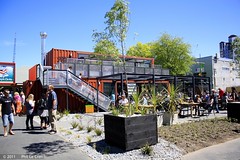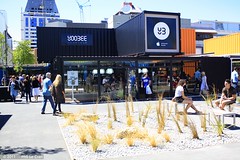
Search
Images for CBD; more images...
Photograph by Jocelyn Kinghorn 2609
Images, UC QuakeStudies
Damage to a property in the CBD. Cracking can be seen along the roof and footpath, and the garage in the right background looks distorted.
Peter Walker Photograph 10
Images, UC QuakeStudies
A police officer giving assistance to members of the public while guarding the CBD cordon. A couple of other people are looking into the city cordon.
Is This One on the Endangered Species List
Images, UC QuakeStudies
A broken window decorated with a lizard emblem on a building on Hereford Street. The photographer comments, "Many of the buildings are waiting to be demolished. As this one has been abandoned it is probably on the list".
I'll Kiss It Better
Images, UC QuakeStudies
Digitally manipulated image of graffiti on a brick building on St Asaph Street. The graffiti depicts a sticking plaster over a broken section of the wall, with the words "I'll kiss it better". The photographer comments, "After the 22 February 2011 earthquake in Christchurch band aid plasters starting to appear in different parts of the city on damaged buildings. A year later most can still be seen. This one was once a whole plaster, but it has slowly broken up where it crossed the gap. The red bricks seen to symbolise the terrible wounds caused to the City and it's people".
Lux City
Images, UC QuakeStudies
A digitally manipulated image of light sculptures on Gloucester Street during the LuxCity event. The photographer comments, "This was part of the LuxCity event in Christchurch, New Zealand. It was a way of creating a city of lights on the sites of demolished buildings in the earthquake devastated red zone. 350 architecture and design students from all around New Zealand created and constructed 16 pop up spaces".
In Technicolor
Images, UC QuakeStudies
A digitally manipulated image of demolition machinery, with the Hotel So in the background. The photographer comments, "Strange things happen when you use technicolor film".
Photograph by Jocelyn Kinghorn 1833
Images, UC QuakeStudies
A damaged house inside the CBD cordon, seen through a fence. On the doors are signs that say 'Danger Keep Out' and 'Danger do no enter'.
Christchurch Press Infographic: 16 November 2012 (1)
Images, UC QuakeStudies
An infographic showing planned changes to transport in the central city.
Christchurch Press Infographic: 16 November 2012 (2), public transport
Images, UC QuakeStudies
A map showing proposed public transport routes in the central city.
Hearing into Canterbury earthquakes begins today
Audio, Radio New Zealand
The Royal Commission hearings into the Canterbury earthquake begin in Christchurch today to examine why some of the newer buildings in the city's CBD failed so badly.
Canta Volume 82 Issue 1, 23 March 2011
Articles, UC QuakeStudies
Canta Magazine Volume 82 Issue 1 from 23 March 2011.
Christchurch Press Infographic: 16 November 2012 (2), cycling and walking
Images, UC QuakeStudies
A map showing proposed cycling and walking routes in the central city.
Christchurch Press Infographic: 24 November 2012 (3)
Images, UC QuakeStudies
A page banner promoting an article titled, "Change of heart: 70-year-old aerial photo found".
Photograph by Jocelyn Kinghorn 554
Images, UC QuakeStudies
High-rise buildings in the CBD seen over a concrete wall. From the left are the Hotel Grand Chancellor, the Westpac building and the Holiday Inn City Centre.
Photograph by Jocelyn Kinghorn 2436
Images, UC QuakeStudies
Some public working on the outside of the CBD cordon at the corner of Gloucester and Cambridge Terrace. Building demolition can be seen in the background towards the right.
CBD plan could be boon for business but bad for democracy
Audio, Radio New Zealand
The Christchurch City Council's control of the earthquake recovery plan has been taken out of its hands, to the delight of business leaders, but to the chagrin of some local councilors.
Nisbet, Alistair, 1958- :New lightweight buildings for CBD? 16 February 20…
Images, Alexander Turnbull Library
Refers to the rebuilding of Christchurch after the earthquakes. Shown are a cardboard 'weetbix' box, a condom brothel that gives great protection, a pile of rolls of toilet paper, the 'popcorn hotel' expands in microwave, the 'Milo' building, soft but reinforced with iron', and the 'styrofoam chalice'. Quantity: 1 digital cartoon(s).
Considerations on the seismic performance of pre-1970s RC buildings in the…
Research papers, University of Canterbury Library
The 4th of September 2010 Mw 7.1 Darfield (Canterbury) earthquake had generated significant ground shaking within the Christchurch Central Business District (CBD). Despite the apparently significant shaking, the observed structural damage for pre-1970s reinforced concrete (RC) buildings was indeed limited and lower than what was expected for such typology of buildings. This paper explores analytically and qualitatively the different aspects of the "apparent‟ good seismic performance of the pre-1970s RC buildings in the Christchurch CBD, following the earthquake reconnaissance survey by the authors. Damage and building parameters survey result, based on a previously established inventory of building stock of these non-ductile RC buildings, is briefly reported. From an inventory of 75 buildings, one building was selected as a numerical case-study to correlate the observed damage with the non-linear analyses. The result shows that the pre-1970s RC frame buildings performed as expected given the intensity of the ground motion shaking during the Canterbury earthquake. Given the brittle nature of this type of structure, it was demonstrated that more significant structural damage and higher probability of collapse could occur when the buildings were subjected to alternative input signals with different frequency content and duration characteristics and still compatible to the seismicity hazard for Christchurch CBD.
Caged Animals
Images, UC QuakeStudies
People peer through the cordon fence outside Ballantynes. The photographer comments, "Whilst on the CERA red zone coach tour we passed Ballantynes and felt like caged animals. There was crowds watching us and we were caged inside the CERA coach with our keepers to make sure we were not allowed to escape our confines".
The Boulevard of Broken Dreams
Images, UC QuakeStudies
A digitally manipulated photograph of the sign for the Boulevarde restaurant. The photographer comments, "The title is very appropriate as this restaurant was closed after the February Christchurch earthquake. The area has been cordoned off for ages now and everything will probably be demolished.
No 8, Merchants of Fine Wine
Images, UC QuakeStudies
A digitally manipulated photograph of a building on Poplar Lane. The photographer comments, "I felt that this building had a real Italian feel about it. It is actually in Christchurch, New Zealand. It appears on the list to be partially demolished after the Christchurch earthquake, so it might not be around for much longer".
Polson's Paint Wall Sign
Images, UC QuakeStudies
An old advertising sign exposed by the demolition of an adjoining building. The photographer comments, "'Protect your investment. Paint your property regularly - and save money. Polson's decorators and sign writers.' The building that was adjacent to this one was demolished after the Christchurch earthquake and revealed this fabulous old wall sign.
Stone By Precious Stone
Images, UC QuakeStudies
A protest sign painted on a fence shows an image of the cathedral spire and the words "Save + restore, stone by precious stone!" The photographer comments, "The Christchurch Cathedral got very badly damaged in the earthquake. It was being demolished down to a safe level before a major protest managed to stop it going too far. There is still an ongoing debate on what to do with the Cathedral. In the meantime a cardboard cathedral made out of a steel framework and massive toilet roll tubes is being constructed close by. This is to the right of the protest about the closure of Christchurch schools".
Christchurch Press Infographic: 17 November 2012 (1)
Images, UC QuakeStudies
The front page graphic for the Mainlander section of The Press, featuring an article about the retail precinct.
Hundreds of engineers assess damage in Christchurch
Audio, Radio New Zealand
Hundreds of engineers are on the ground in Christchurch, assessing the damage in the wake of Tuesday's earthquake and are heading into the CBD en masse for the first time.
Christchurch Press Infographic: 16 November 2012 (2), road system
Images, UC QuakeStudies
A map showing proposed changes to speed limits on roads in the central city.
Photograph by Jocelyn Kinghorn 2655
Images, UC QuakeStudies
Looking inside the CBD cordon at the intersection of Tuam and Manchester Streets. The The Odeon Theatre and the Pink Pussy Cat Building formerly Lawrie & Wilson Auctioneers can seen in the background.
MtPleasantApril2013EDgold
Images, eqnz.chch.2010
Christchurch CBD earthquake rebuild lit in the last fading golden glow of the day - taken with 70-200 F4 IS from Mt Pleasant. I count at least three big cranes!
Southern Story for 21 February 2013 - Earthquake Anniversary
Audio, Radio New Zealand
Christchurch prepares for a challenging anniversary - two years on from the devastating earthquake that killed 185 people. Our correspondent there, Katy Gosset, hears the stories of local baristas who were in the CBD that day.
This was the Cathedral of the Blessed Sacrament
Images, UC QuakeStudies
A digitally manipulated image of the dome of the Cathedral of the Blessed Sacrament.



